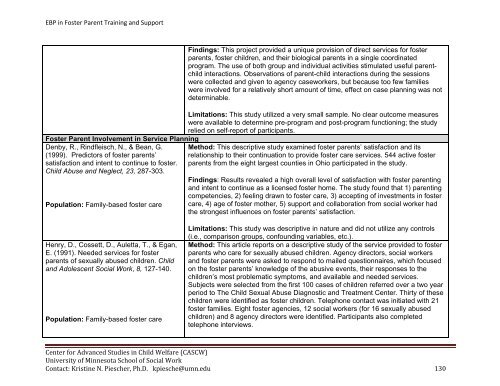Evidence-Based Practice in Foster Parent Training and Support ...
Evidence-Based Practice in Foster Parent Training and Support ...
Evidence-Based Practice in Foster Parent Training and Support ...
Create successful ePaper yourself
Turn your PDF publications into a flip-book with our unique Google optimized e-Paper software.
EBP <strong>in</strong> <strong>Foster</strong> <strong>Parent</strong> Tra<strong>in</strong><strong>in</strong>g <strong>and</strong> <strong>Support</strong><strong>Foster</strong> <strong>Parent</strong> Involvement <strong>in</strong> Service Plann<strong>in</strong>gDenby, R., R<strong>in</strong>dfleisch, N., & Bean, G.(1999). Predictors of foster parents’satisfaction <strong>and</strong> <strong>in</strong>tent to cont<strong>in</strong>ue to foster.Child Abuse <strong>and</strong> Neglect, 23, 287-303.Population: Family-based foster careF<strong>in</strong>d<strong>in</strong>gs: This project provided a unique provision of direct services for fosterparents, foster children, <strong>and</strong> their biological parents <strong>in</strong> a s<strong>in</strong>gle coord<strong>in</strong>atedprogram. The use of both group <strong>and</strong> <strong>in</strong>dividual activities stimulated useful parentchild<strong>in</strong>teractions. Observations of parent-child <strong>in</strong>teractions dur<strong>in</strong>g the sessionswere collected <strong>and</strong> given to agency caseworkers, but because too few familieswere <strong>in</strong>volved for a relatively short amount of time, effect on case plann<strong>in</strong>g was notdeterm<strong>in</strong>able.Limitations: This study utilized a very small sample. No clear outcome measureswere available to determ<strong>in</strong>e pre-program <strong>and</strong> post-program function<strong>in</strong>g; the studyrelied on self-report of participants.Method: This descriptive study exam<strong>in</strong>ed foster parents’ satisfaction <strong>and</strong> itsrelationship to their cont<strong>in</strong>uation to provide foster care services. 544 active fosterparents from the eight largest counties <strong>in</strong> Ohio participated <strong>in</strong> the study.F<strong>in</strong>d<strong>in</strong>gs: Results revealed a high overall level of satisfaction with foster parent<strong>in</strong>g<strong>and</strong> <strong>in</strong>tent to cont<strong>in</strong>ue as a licensed foster home. The study found that 1) parent<strong>in</strong>gcompetencies, 2) feel<strong>in</strong>g drawn to foster care, 3) accept<strong>in</strong>g of <strong>in</strong>vestments <strong>in</strong> fostercare, 4) age of foster mother, 5) support <strong>and</strong> collaboration from social worker hadthe strongest <strong>in</strong>fluences on foster parents’ satisfaction.Henry, D., Cossett, D., Auletta, T., & Egan,E. (1991). Needed services for fosterparents of sexually abused children. Child<strong>and</strong> Adolescent Social Work, 8, 127-140.Population: Family-based foster careLimitations: This study was descriptive <strong>in</strong> nature <strong>and</strong> did not utilize any controls(i.e., comparison groups, confound<strong>in</strong>g variables, etc.).Method: This article reports on a descriptive study of the service provided to fosterparents who care for sexually abused children. Agency directors, social workers<strong>and</strong> foster parents were asked to respond to mailed questionnaires, which focusedon the foster parents’ knowledge of the abusive events, their responses to thechildren’s most problematic symptoms, <strong>and</strong> available <strong>and</strong> needed services.Subjects were selected from the first 100 cases of children referred over a two yearperiod to The Child Sexual Abuse Diagnostic <strong>and</strong> Treatment Center. Thirty of thesechildren were identified as foster children. Telephone contact was <strong>in</strong>itiated with 21foster families. Eight foster agencies, 12 social workers (for 16 sexually abusedchildren) <strong>and</strong> 8 agency directors were identified. Participants also completedtelephone <strong>in</strong>terviews.Center for Advanced Studies <strong>in</strong> Child Welfare (CASCW)University of M<strong>in</strong>nesota School of Social WorkContact: Krist<strong>in</strong>e N. Piescher, Ph.D. kpiesche@umn.edu 130
















